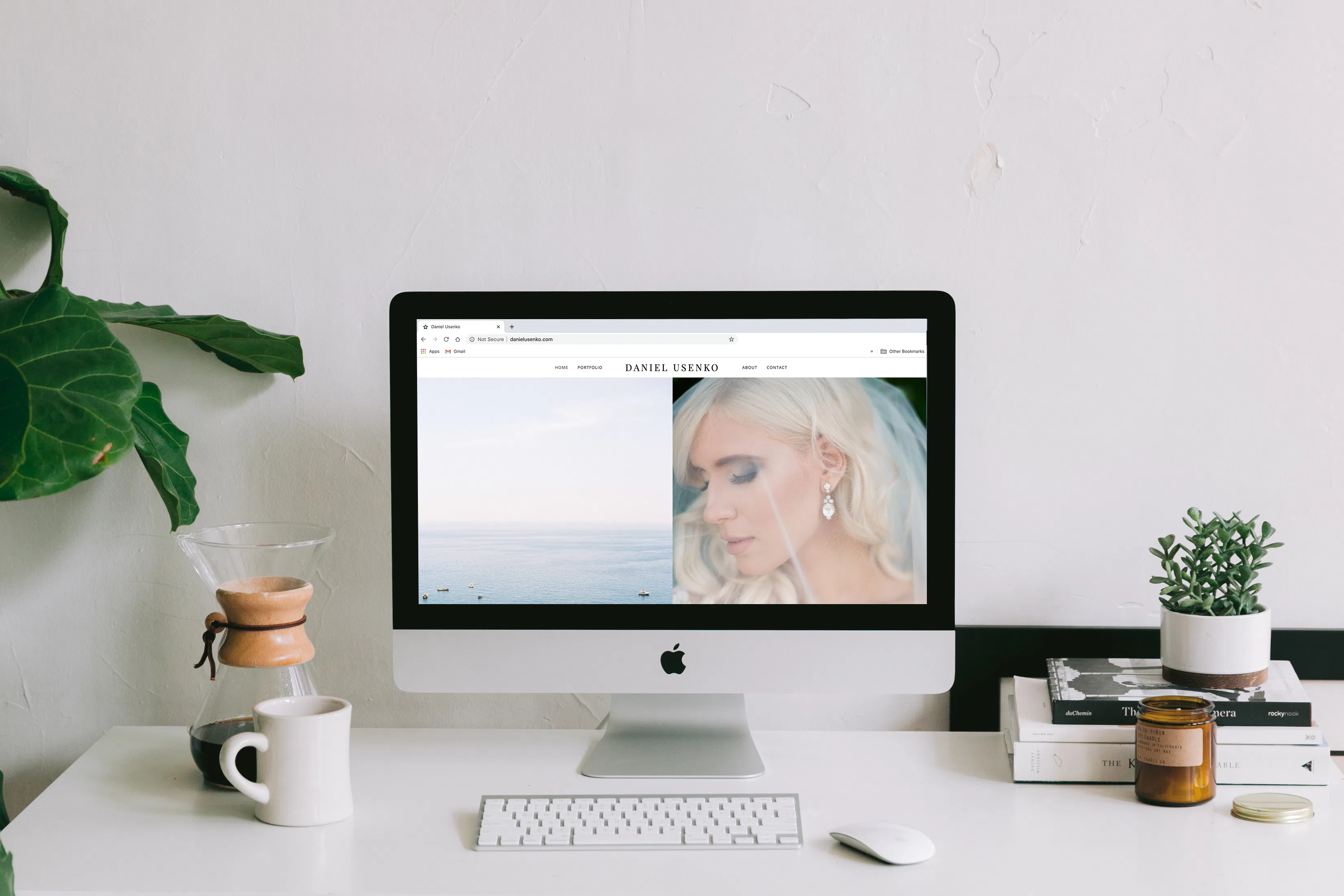Guest Post: How to Use Landing Pages to Grow Your Photography Business
If 2020 taught us anything, it’s that you have to be ready to pivot and adapt your photography business, fast. And regardless of what turn you take — photographing more elopements and intimate couple sessions, offering product photography or preset packs, sharing mentorship and online courses — you will need landing pages to build a strong and steady flow of clients.
If you’re not familiar with what landing pages are, why you need to use them for your photography business and how to make a landing page convert better — keep reading!
This article is brought to you by Flothemes, a popular WordPress website provider for photographers and creative entrepreneurs.
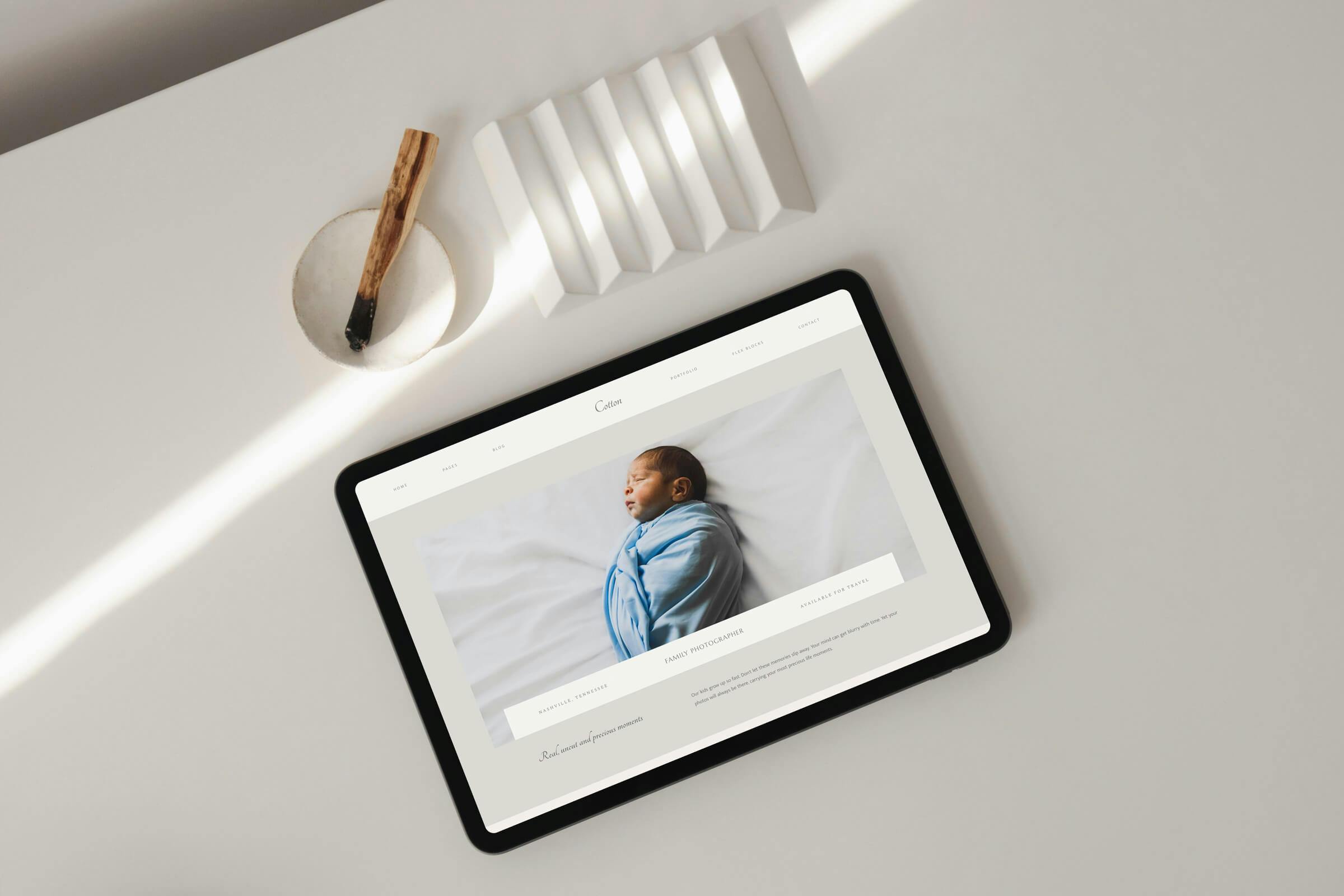
What is a landing page?
By definition, a landing page is the web page that you “land on” after clicking on a social media post, an advertisement, a search result in Google, etc. It’s basically the page that serves as your entry point for a particular website.
In marketing terms, a landing page is a page created and optimized for a specific purpose.
This can be to sell a product, to promote an event, to collect emails, to ask people to fill out a form or sign up for a webinar, etc. The design, content, and structure of the landing page are all shaped out in a way that reduces distractions and motivates the user to take an action.
Why use a landing page for your photography business?
There are a few reasons why you may want to consider using landing pages for your photography business:
1. To increase conversions (get better results)
No matter what your end goal is (get more inquiries, grow your email list, sell more preset packs, etc), a landing page can help you get higher results than what you’re currently getting through your regular website pages. How? It’s designed in a way that removes all distractions and unnecessary links. It has very targeted content, focused on the user’s needs and wants, and focuses on one single call to action.
2. To improve SEO (rank better online)
Landing pages can help you strengthen your SEO and online discoverability, as they are focused on specific topics and keywords. For example, if you’re a destination photographer, you’ll want to create separate landing pages for each location that you serve and want to shoot at (i.e. Fine-art wedding photographer UK, Adventurous Elopement Photographer New Zealand). If you’re a local vendor, you can target search results focused on specific areas or venues in your city. The narrower and more specific are your keywords, the higher are your chances to get found.
3. To optimize marketing costs (and get a higher return on investment)
Whether you’re doing paid advertising, invested in a new tool, hired a team/assistant to help you with marketing, or are working around the clock to get your photography brand out there — these are all financial or personal costs, that ideally should pay off. By creating targeted landing pages, tailored to the needs of various groups of people, you increase your conversion rate, which in turn lowers your cost per conversion. In other words, you get more clients for the same investment.
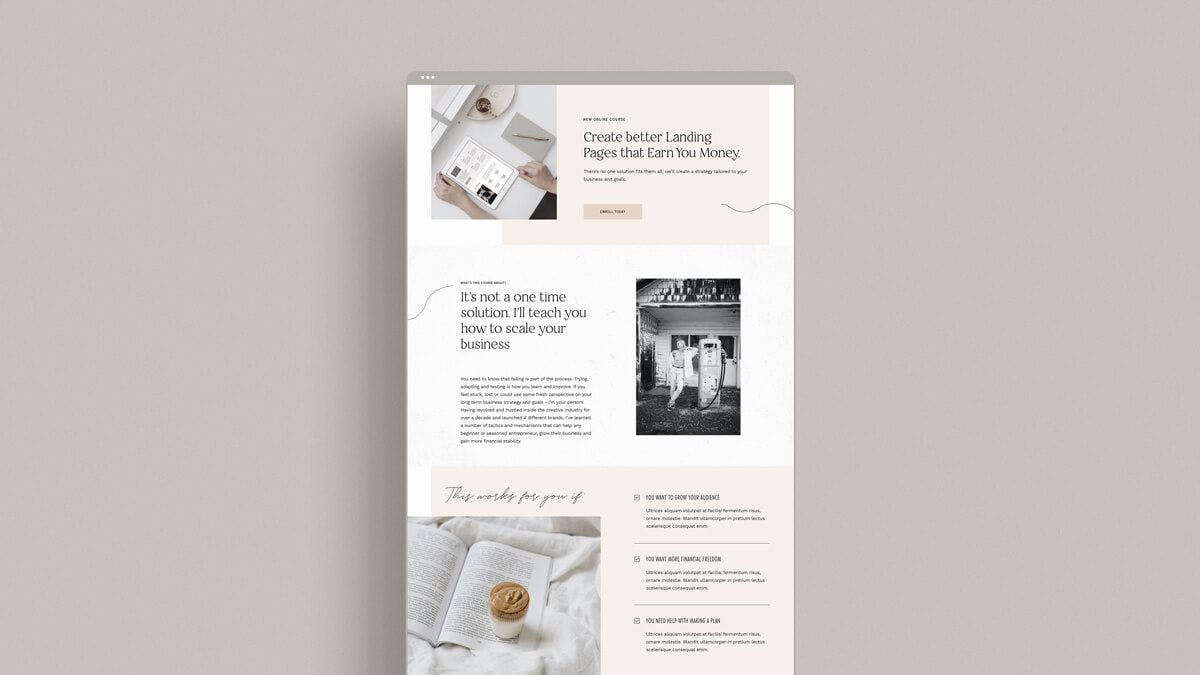
Landing page template included with Nessa theme
Before you start building a landing page
Before you jump into planning out the design and writing out copy for your landing page, you need to cover the fundamentals. Define the goal of your landing page and the target audience. These will help you stay focused and filter out any sections that don’t contribute to the main goal.
And yes, we do recommend writing out a rough outline for your landing page before you actually start building it. This can help you visualize the flow of the page and determine how you want to present each piece of information — think video, bullet points, illustrations, gifs, etc.
Once you have all the details planned out, the rest is smooth sailing, at least when you’re building your landing pages with tools like Flothemes & FlexBlock.
6 essential things every highly converting landing page should include
Use Copy that Helps You Convert
People buy products that help (or promise to help) them solve their problems. You can have the best quality product or service on planet Earth, yet if you don’t know how to sell it, people won’t buy it. They will choose a lower quality product that does a better job at clearly communicating its benefits and vouching to solve their problems, fast.
Before you start writing out the texts for your landing page — the headings, the paragraphs, the bullet points, and the CTAs — write down the main pain points and needs of your potential clients. What are they looking for and what do they care about in regards to your service or product?
If we’re talking about wedding photography, what’s important to brides and grooms? Why would they choose you over a competitor? Is it your witty personality? Your unique photography and editing style? Your professionalism and speedy delivery timeframes?
If your product is a mentoring session, what’s so special about it? What will your mentee learn? How much guidance is provided and what actionable steps does it cover? Is it tailored to each mentee and their business type?
Always try to focus on the end-user. Describe how your service or product will transform their life. How will it solve their need or problem? How will they feel after they perform the action that you want them to take?
The narrative writing approach is very popular and highly effective with landing pages. You basically write out all the texts for your page in a story format. You address the reader directly and have a conversation with them (similar to an elevator pitch). It starts with a strong question or statement that gets them curious or intrigued since it tackles a topic that matters to them. Then, you jump into describing a relatable scenario, or a list of issues (pain points) that they identify themselves with. After, you proceed to describing a solution and explain how exactly it will solve their problem and transform their lives for the better. Finally, you add urgency — a deadline or limited special deal that requires the user to make a decision asap.
Here’s an example of a landing page that uses the narrative approach.
Here’s another example by Ideaction Consulting, which also includes strong, to the point copy.
Additional tips:
- Use headings or bullet points to highlight the main benefits and the value those who convert will get. People tend to skim through pages — they read the information in smaller print only if the title or keywords caught their attention. Use those wisely.
- Your first and main heading on the landing page should either address a pain point or make a desirable promise. For example, if you’re selling a course that helps photographers increase bookings that come through their website, the title of the page could be focused on the problem they’re struggling with — “Tired of getting crickets on your website?” or “Why are your contact form submissions so low?”
- It can also be focused on a desirable outcome — “3 actionable steps to booking more clients through your website” or “Fix your website. Make more money. Live a happy life” — now who would say no to this kind of statement? If I’m currently struggling financially, if I’m not getting enough business through my website, if I’m not fully satisfied with my current life, reading this title will get me curious and hopeful. The question now is, will you manage to hold my attention throughout the rest of the page and convince me to click that button and order the course?
- You know your products/services too well, and sometimes that can get in the way, as you’re trying to impress your prospects and tell them EVERYTHING that you can do for them. Yet be careful not to overload your reader with too much information, as that can delay the decision-making process. It can also bore or confuse your reader.
- Be direct, don’t go around the bush, you’re wasting your readers’ and your time.
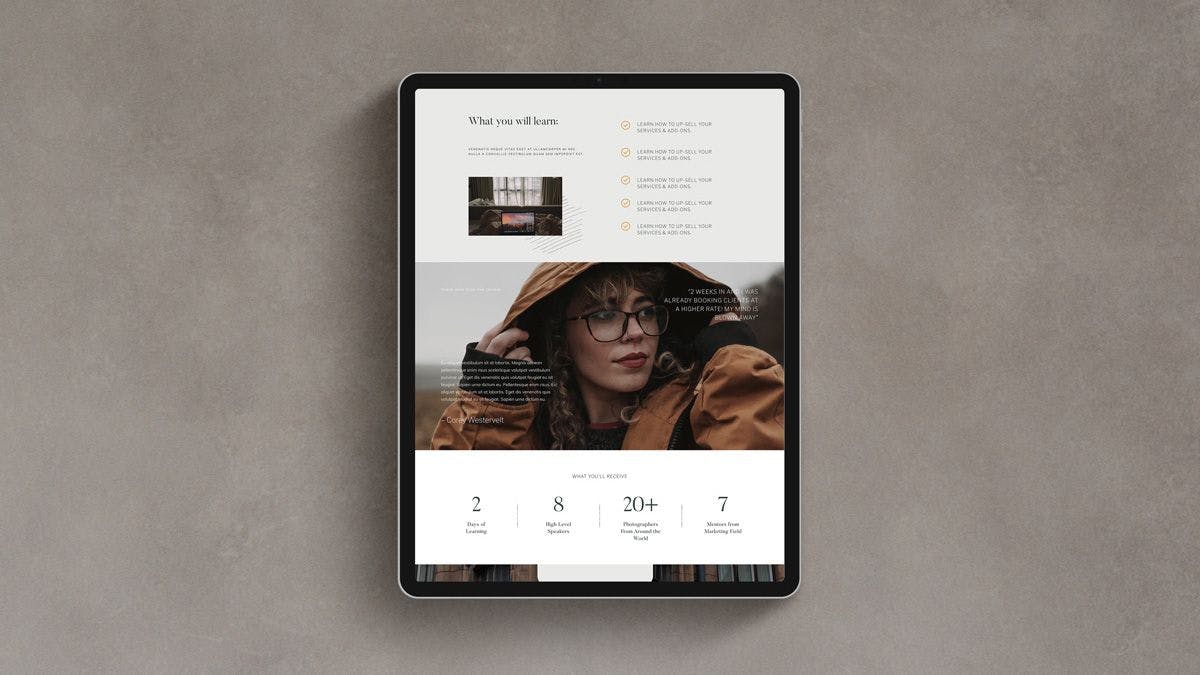
Landing page templates included with Ember theme
Keep Content Short & Relevant
If you’re familiar with Donald Miller and the StoryBrand framework, you’ve probably heard him say - "people don't buy the best products, they buy the products they can understand the fastest.” Which is absolutely true. Have you ever landed on a website that got you wondering what exactly does the brand offer? Or a website that has so much information, tabs, buttons, and sections that you’re literally getting a headache while trying to figure out where to click and how to find the information that you need? Not a fun experience, right? So don’t do that to your users.
List out and explain only the most important and crucial details that directly affect the decision-making process. Make the content relevant to the type of users who will land on this page. For example, if you’re creating a landing page to promote your elopement photography services for those who plan to get married in Iceland, speak only about that. Look through the questions and messages you got from previous clients — what do they worry about? What is important for them? What gets them excited and confident about hiring you? Build your landing page around those key points. Show examples of client galleries you shot in Iceland, list out some of the top locations you recommend. Include a behind-the-scenes video to help your prospect get a better feel of the whole experience. Video content can be very powerful and inspire your prospect to reach out.
Additional tips:
- Remove any sections, texts, or elements that don’t contribute to the main goal of converting the user. Eliminate any distractions or unnecessary links.
- Keep the copy brief and to the point. Use headings so it’s clear what the page is about, even to those who just skim through.
- Add contact information, a live chat (connected to your Facebook messenger), or any other means through which a user can reach out to you, in case they are hesitant to convert, yet interested enough to inquire.
- Consider adding an FAQ section to your landing page, where you handle the most common questions and concerns that your prospects have. If you’re not sure what information to include in this section, revisit old emails and conversations that you had with clients, those are gold mines of insights.
- If you have a form on your landing page, try to keep it short. Don’t scare your prospects away with too many questions and info requirements. All you need from them at this stage is their interest and intent to hire you. The rest you can sort out during a phone or video call.
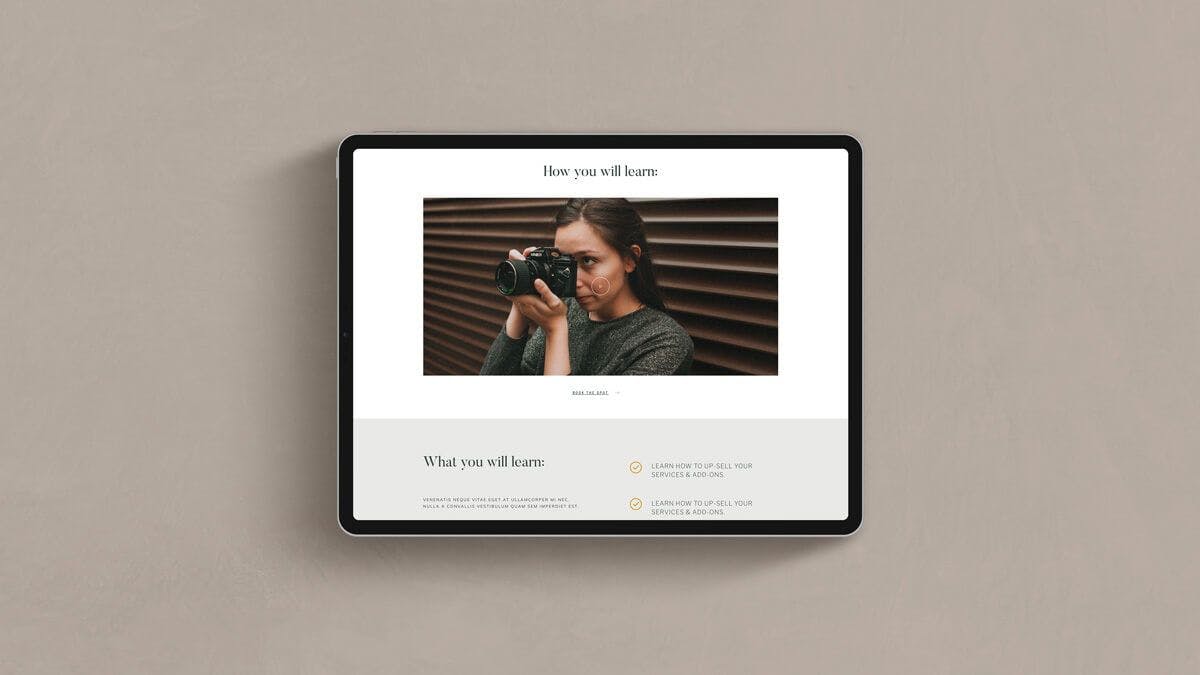
Landing page templates included with Ember theme
Clear CTAs (Call-To-Action)
The more options you offer to a user, the harder it gets for them to make a decision and take action. Plus, you’re diluting the main purpose of your landing page.
Keep it simple and give clear guidance to your user on what they should do next - “Sign up today”, “Book Your Spot”, “Claim this Deal”, etc. Use just one call-to-action, yet repeat it a few times throughout your landing page - so the person who’s browsing doesn’t have to scroll all the way back up or to the bottom of your page to find the button.
Additional tips:
- Your CTA (call-to-action) needs to be an actual button, not hyperlinked text, so it’s visible right away.
- Make your button visible through design and colors, and keep its styling consistent throughout the whole landing page.
- If you need to include a secondary link on your landing page, for more information, hyperlink that one, so it doesn’t visually compete with the main CTA.
- It’s a common practice to hide the navigation bar on landing pages, as it leads users away from your “sales” page.
Urgency or Scarcity
This is the key to higher conversion rates on your landing page, as it motivates users to take action faster. By introducing a deadline or some sort of scarcity due to a limited amount of discount codes, seats, packages, etc. you’re letting your prospect know that they may miss this amazing opportunity if they don’t jump on board asap.
Some ideas to consider:
- Add a timer to your landing page, at the top, and at the bottom where you have your final call-to-action. Here’s an example.
- Have a special limited offer on your product or service. It can be limited by time, such as “only till December 15th,” or limited by the amount, for example, “only 5 spots left.”
Social Proof
We are social creatures who place a lot of importance on things and products that other people approve and recommend. We no longer trust sneaky marketers and their fancy communication tactics. We want to know what real people have to say about their experience with the product or services. We want to know whether they got the promised results. Whether this product or service is worth the investment. And the more people vouch for it, the better.
Adding testimonials and reviews from clients who have had experience with your brand is paramount. Curate reviews that are specific and describe how your service or product helped them, excelled their expectations or addressed a major pain point that they had. Basically, your social proof should reiterate the benefits of your product or service and highlight why one should hire you over a competitor.
Additional tips:
- Include a photo and the full name of the person who shared the testimonial. This makes it look more trustworthy. If the landing page is to sell a photography service, link their testimonial to their photo gallery, to show a detailed example of their “end product”.
- Short, punchy testimonials are always better than super lengthy ones because people are too lazy to read them. Highlight the part where your client mentions measurable results, or problems that you helped resolve, and feature that.

Layouts included with Mono theme
Mobile First
It’s 2021, if you’re still not prioritizing the experience your users have on mobile devices, you’re in trouble. Everything happens via phones now. Everyone is browsing, checking emails, messaging, video conferencing via their mobile devices. They do Google searches, click on ads, and swipe up from Instagram stories via their phone. This means that most of them will probably access your landing page also through their mobile device. Will they have a good experience? Will it load fast? Will it look good? Is the text readable? Are the buttons easy to see and click on?
Be sure to run some tests via various phones and browsers, including asking your friends to check your page. If you need to, personalize and tweak the page content specifically for your mobile users. Hide the sections that are not crucial for decision making, to make your page shorter. Add additional buttons, to ensure a smooth and seamless browsing path.
Additional tips:
- Keep it loading fast, optimize all images and videos so the page size is under 2-3 MB.
- Make sure all headings and CTAs (call-to-action buttons) are visible and accessible at all times.
Further Things to Consider
Here are a few more things that can help you build a strong landing page with a high potential to convert users:
Track Your Metrics
Ideally, you have your whole website connected to a Google Analytics account so that you can analyze your traffic and make decisions based on that. If this is the case, just continue doing the same thing with your landing pages. A/B test various ideas (one thing at a time) and make adjustments based on stats.
You can also consider installing a heat mapping tool, such as CrazyEgg or HotJar, to get a more accurate understanding of how users interact with your landing page. Identify the areas that need to be improved, based on how people scroll through your page — where do they click? Which areas do they read? Which sections do they completely ignore?
Exit-Intent Pop-Ups
If you want to go an extra step and ensure that even the least interested users are given maximum incentives to convert, you can try to enable an exit-intent pop-up on your landing page. This is a pop-up that activates when the user is about to close their browser tab and exit your page. Try to offer something really good that they can’t say no to. For example, an exclusive discount code, a downloadable freebie, or a free consultation call. All they have to do to get this special incentive is sign up with their email. This allows you to collect their information and further nurture this user until the point they are ready to convert.
_____
How to build landing pages with Flothemes
If your current website provider doesn’t offer you the freedom to design functional and impactful pages for your website — be that a landing page to fulfill a certain goal, or a custom investment page to present your approach, your value, your packages, and past client experiences — it may be time to look into Flothemes.

Example of the Flex editor available with any Flothemes design
Each website design by Flothemes is tailored to photographers, their needs, and their businesses. The templates come with a beautiful selection of pre-made page layouts for your Home, About, Portfolio, Services pages, Contact information, Instagram quick links, as well as options for landing pages. Here are some examples of pre-made templates you can find inside Flothemes designs:
- Landing page for Online Courses - included with Nessa theme
- Landing page for mentoring session / consultancy - included with Nessa theme
- Landing page for an Online Course / webinar - included with Ember theme
- Landing page for an Online Workshop - included with Ember theme
- Landing page for a location based Elopement - included with Nomade theme
You can use these page templates right out of the box, or fully customize everything, from fonts, colors, and page structure, to the elements inside various sections on the page.
It’s simple. It’s fun. It doesn’t require any code.
And, all Pixellu clients and friends enjoy a 25% OFF discount on all Flothemes designs. Pick your favorite website template, apply code PIXELLU on the cart page, and create a website that you’re proud to send clients to — a website that works as hard as you do to sell your work and get your brand out there!
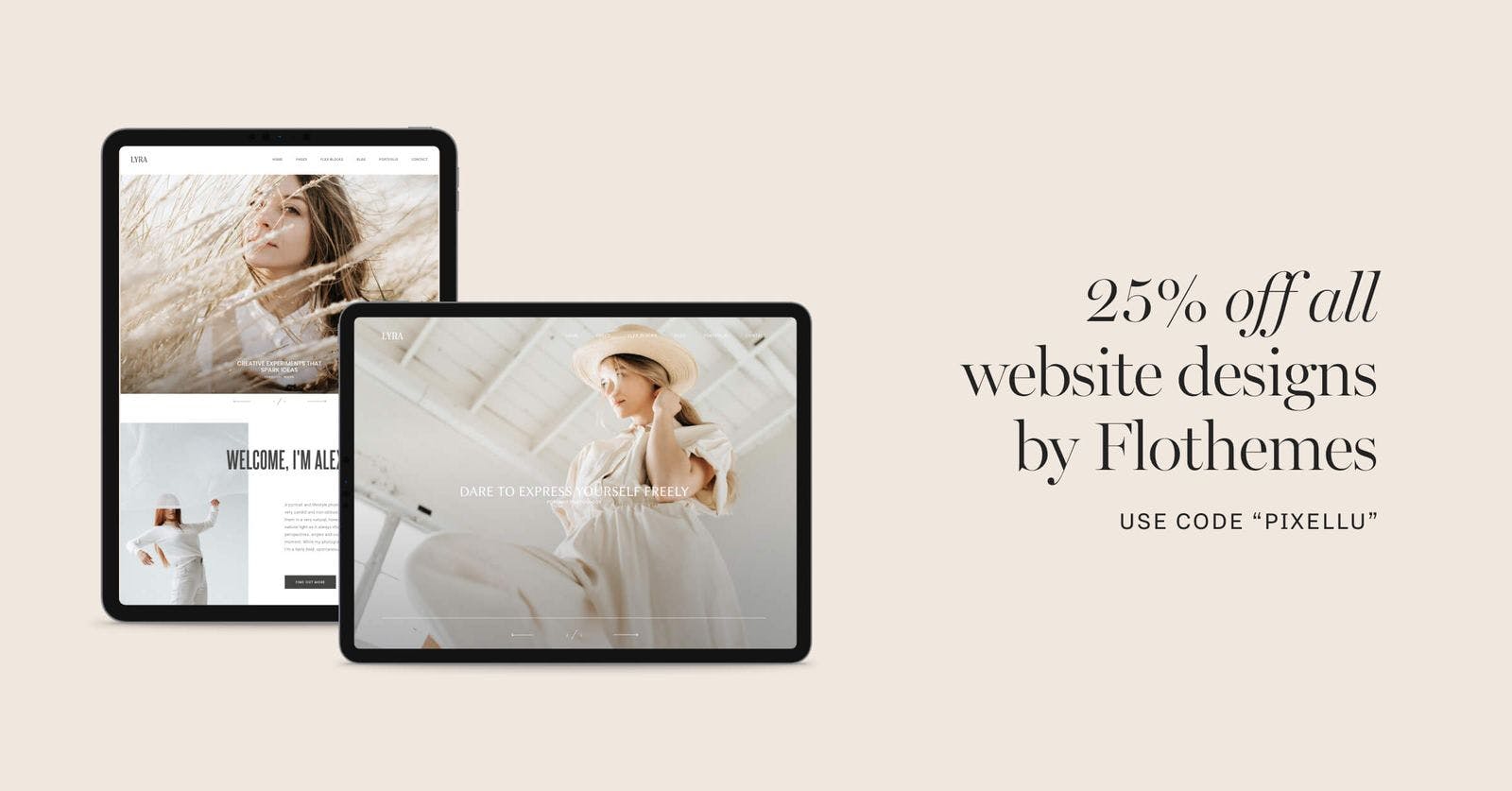
If you’re curious to learn what other people say about Flothemes and their website building experience, you can find some client reviews here, and on their Facebook page. Also, make sure to check out these rad photography website examples build by Flothemes clients.

